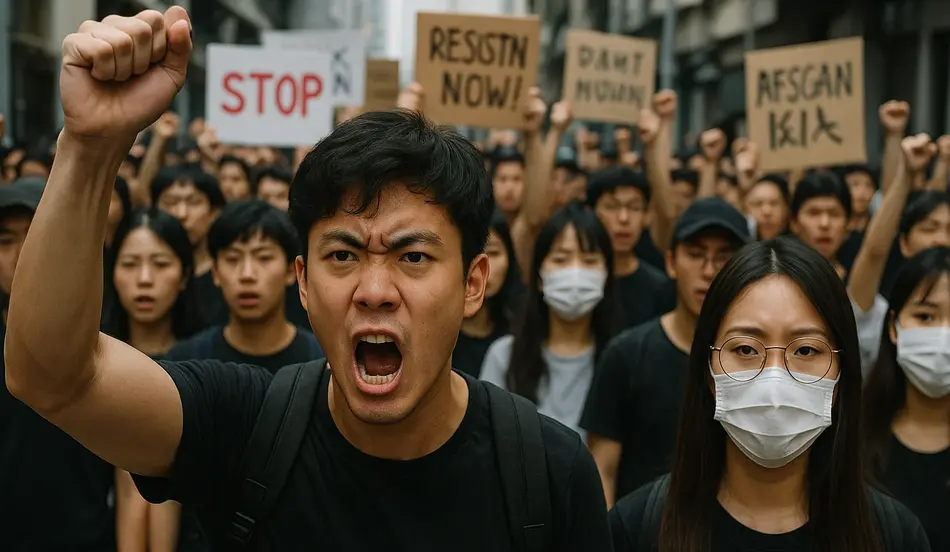Gen-Z protests are spreading across Asia in an unprecedented wave of youth-led movements that are fundamentally reshaping the political landscape from Nepal to the Philippines. These protests, driven by deep frustration with corruption, economic inequality, and unaccountable governance, represent a new form of political activism that leverages social media to organize, inspire, and coordinate across borders.
The recent uprising in Nepal, where young protesters successfully toppled the government after a social media ban sparked mass demonstrations, exemplifies this new wave of activism. The scenes of government buildings set ablaze and protesters storming the parliament echoed similar successful uprisings in Sri Lanka and Bangladesh, creating a pattern that’s now spreading across Southeast Asia.
What makes these protests unique is their generational character and their reliance on digital platforms for organization and mobilization. Unlike traditional political movements tied to established parties, these Gen-Z led protests are largely leaderless, grassroots movements that use social media to bypass traditional political structures and directly challenge entrenched elites.
The underlying causes driving these protests are remarkably consistent across countries: endemic corruption, poor economic opportunities, and governments that appear out of touch with the needs and aspirations of young people. In an era of unprecedented connectivity, these frustrations are finding expression through coordinated, cross-border movements that are proving remarkably effective at achieving political change.
A Global Call for Change
Endemic corruption, limited opportunities, and disconnected leadership are fueling youth-led movements across the world. Employers can help bridge the gap by creating real opportunities that give young people a stake in the future. Post your job on WhatJobs today and connect with the next generation eager to make a difference.
Post a Job Free for 30 Days →The Nepal Uprising: A Template for Success
The recent protests in Nepal provide a perfect case study of how Gen-Z activism can successfully challenge entrenched political systems. The immediate trigger was the government’s decision to ban 26 social media platforms, including Facebook, Snapchat, and YouTube, ostensibly for failing to register with authorities. However, this ban tapped into much deeper frustrations that had been building for years.
Nepal’s political landscape has been characterized by instability and corruption since the country became a democratic republic in 2008. With 14 governments in 17 years, regular Nepalis had grown frustrated at what they saw as power simply cycling through different parties that were all part of the same political elite. The “Nepo kids” trend on TikTok, which highlighted the extravagant lifestyles of political leaders’ children, crystallized this frustration into a powerful critique of privilege and corruption.
The social media ban was seen as an attempt to silence criticism, and it backfired spectacularly. Tens of thousands of young people took to the streets on September 8th, clashing with police and security forces. The government’s use of water cannons, tear gas, and live ammunition resulted in at least 19 deaths, 14 of them aged 28 or younger, further galvanizing the movement.
The protests escalated rapidly, with demonstrators setting fire to the Nepalese parliament and attacking government buildings and the homes of political leaders. Prime Minister KP Sharma Oli announced his resignation the same day, and the country’s army chief and president entered negotiations with representatives from the largely leaderless youth protest movement.
The movement’s choice of 73-year-old former Supreme Court Chief Justice Sushila Karki as interim prime minister reflects a pragmatic approach to the challenge of transitioning from protest to governance. Without established political infrastructure, these movements often turn to respected elders who can provide stability while maintaining distance from the old political elite.
The South Asian Spring: A Regional Pattern
The Nepal uprising follows a clear pattern established by similar movements across South Asia. Sri Lanka’s 2022 uprising saw the powerful Rajapaksa family driven from office as protesters stormed the presidential palace, while Bangladesh’s 2024 protests ousted long-ruling Sheikh Hasina after demonstrators attacked her residence.
While each uprising had its specific triggers – Sri Lanka’s economic crisis, Bangladesh’s quota system for government jobs, Nepal’s social media ban – they all tapped into the same underlying frustrations: endemic corruption, poor economic opportunities, and bad governance. Young people and social media played critical roles in all cases, with protests largely separate from organized political parties.
The aftermath of these uprisings also shows remarkable similarities. Both Bangladesh and Nepal saw youth-led movements put forward conspicuously non-youthful leaders to guide the transition. This reflects the reality that grassroots, leaderless mass movements face considerable challenges after toppling a government, as they lack established political infrastructure.
The choice of elders adjacent to but outside of politics appears to be a sensible short-term strategy. Subsequent elections then provide opportunities for political and generational change. In Sri Lanka, for instance, the old guard was swept away at the 2024 elections, with Anura Kumara Dissanayake becoming the first third-party candidate to be elected president.
The Southeast Asian Expansion
The Gen-Z protest movement has now spread beyond South Asia into Southeast Asia, with similar patterns emerging across the region. Indonesia was rocked by protests in August amid economic frustration and anger at politicians’ perks, while the Philippines saw its own “Nepo babies” online trend and mass protests against corruption involving billions of dollars lost to bogus flood relief projects.
In Timor-Leste, university students led anti-corruption protests demanding that plans to buy a fleet of SUVs for lawmakers be scrapped. These protests share common threads: the prevalence of the One Piece flag as a protest symbol, the leading role played by Gen-Z, underlying frustration at corruption and inequality, and the use of social media to organize demonstrations and share solidarity across borders.
The regional nature of these protests is particularly significant. Young people are not only organizing within their own countries but are also drawing inspiration and tactics from movements in neighboring nations. Social media platforms like TikTok, Discord, and Twitter have become crucial tools for sharing information, coordinating actions, and building cross-border solidarity.
This interconnectedness makes the movements more resilient and harder for governments to suppress. When one government cracks down on social media or uses violence against protesters, it often serves to galvanize movements in other countries, creating a feedback loop of resistance and inspiration.
The Southeast Asian Expansion
Gen-Z movements across Southeast Asia are demanding change — fueled by frustration at corruption, inequality, and a lack of opportunity. Employers can help answer these calls by creating meaningful jobs that empower young people to shape their futures. Post your job on WhatJobs today and connect with ambitious candidates ready to make an impact.
Post a Job Free for 30 Days →The Role of Social Media and Digital Activism
Social media has become the organizing backbone of these Gen-Z protests, serving multiple crucial functions. It provides a platform for sharing information and coordinating actions, bypassing traditional media that may be controlled or censored by governments. It also allows for the rapid spread of protest tactics and symbols across borders.
The “Nepo kids” and “Nepo babies” trends exemplify how social media can be used to highlight corruption and privilege in ways that resonate with young people. By focusing on the extravagant lifestyles of political leaders’ children, these trends make abstract concepts like corruption and inequality concrete and relatable.
Social media also enables the rapid organization of protests and the sharing of real-time information about government responses. In Nepal, protesters used Discord to debate their next steps and coordinate their response to the government’s crackdown. This digital infrastructure allows for more flexible and responsive organization than traditional political structures.
However, social media also presents challenges. Governments can use it to spread disinformation, track activists, and coordinate their own responses. The social media bans that often trigger these protests demonstrate both the power of these platforms and the vulnerability of movements that rely too heavily on them.
The Economic and Social Drivers
The economic and social conditions driving these protests are remarkably consistent across the region. Young people face high unemployment rates, limited economic opportunities, and the perception that the political elite is out of touch with their needs and aspirations. The COVID-19 pandemic exacerbated these conditions, highlighting existing inequalities and creating new ones.
In many countries, young people are better educated than previous generations but face worse economic prospects. This creates a particularly potent form of frustration: the sense that their education and potential are being wasted by a system that doesn’t value or reward their contributions.
The corruption that these protests target is often seen as particularly galling because it represents resources being stolen from the very people who need them most. When young people see political leaders and their families living in luxury while they struggle to find decent jobs or housing, it creates a powerful sense of injustice.
The economic challenges are compounded by demographic factors. Many Asian countries have large youth populations, making young people a significant political force when they become politically active. This demographic reality gives these movements particular power and makes them difficult for governments to ignore.
Frequently Asked Questions
Gen-Z protests are spreading across Asia – what’s driving this movement?
Gen-Z protests are spreading across Asia due to deep frustration with endemic corruption, poor economic opportunities, and unaccountable governance, with young people using social media to organize and challenge entrenched political elites.
How did the Nepal uprising succeed in toppling the government?
The Nepal uprising succeeded by mobilizing tens of thousands of young people through social media after a government ban on platforms like Facebook and TikTok, with protesters using violence and building attacks to force the prime minister’s resignation.
What role does social media play in these Gen-Z protests?
Social media serves as the organizing backbone for Gen-Z protests, enabling rapid coordination, information sharing, and cross-border inspiration, while also making movements vulnerable to government censorship and surveillance.
Why are these protests spreading from South Asia to Southeast Asia?
These protests are spreading because young people across the region face similar economic challenges and corruption, with social media allowing them to share tactics and inspiration across borders, creating a feedback loop of resistance.
How are governments responding to these Gen-Z movements?
Governments are responding with mixed strategies, including suppression through force and censorship (which often backfires), co-optation by addressing some demands, and recognition that these movements represent a significant political force that cannot be ignored.
What challenges do these movements face after toppling governments?
These movements face the challenge of transitioning from protest to governance, lacking established political infrastructure and often turning to elder statesmen as interim leaders while working to create lasting political change.
A Real-World Example: The Student Activist’s Journey
Aisha Rahman, a 22-year-old university student in Dhaka, Bangladesh, became involved in the anti-corruption protests that eventually toppled the government. “I never thought I’d be part of something that could actually change our country,” she explains. “But when I saw the ‘Nepo babies’ trend on TikTok, it made me realize how much corruption was happening right in front of us.”
Aisha’s involvement began when she started sharing videos about the extravagant lifestyles of politicians’ children, using the hashtag #NepoBabies to highlight the contrast between their privilege and the struggles of ordinary young people. “We were all struggling to find jobs after graduation, while these kids were driving expensive cars and living in mansions,” she says.
The movement gained momentum when students began protesting against the quota system for government jobs, which they saw as another example of unfair privilege. “The system was rigged against us,” Aisha explains. “Even if we scored higher on exams, we couldn’t get jobs because of these quotas that favored certain groups.”
Aisha and her fellow activists used social media to organize protests and share information about government corruption. “We used WhatsApp groups to coordinate, TikTok to spread awareness, and Twitter to share real-time updates about what was happening,” she says. “Social media was our weapon against a system that tried to silence us.”
The protests escalated when the government responded with violence, using tear gas and rubber bullets against peaceful demonstrators. “That’s when we knew we had to keep going,” Aisha says. “They were trying to scare us, but it just made us angrier and more determined.”
The movement’s success in forcing the government to resign was a turning point for Aisha and her generation. “We proved that young people can make a difference,” she says. “We showed that we won’t accept corruption and inequality anymore.”
However, the transition from protest to governance has been challenging. “We toppled the government, but now we have to figure out how to build something better,” Aisha explains. “It’s not as easy as just protesting. We need to learn how to govern and how to create lasting change.”
Aisha’s advice to other young activists reflects the lessons she’s learned. “Don’t be afraid to speak up and organize,” she says. “Use social media to your advantage, but also build real connections with people in your community. And remember that change takes time and persistence.”
Aisha’s story demonstrates that while these movements can achieve dramatic political change, the real work begins after the protests end. The challenge is not just to topple corrupt governments but to build better alternatives that can address the root causes of the problems they’re protesting.
Don’t Underestimate the Power of Youth Activism
The Gen-Z protests spreading across Asia represent a fundamental shift in how young people engage with politics and challenge entrenched power structures. These movements are not just about specific grievances but about a broader demand for accountability, transparency, and fairness in governance.
The success of these movements in achieving political change demonstrates the power of youth activism when it’s properly organized and mobilized. By using social media to bypass traditional political structures and directly challenge corruption and inequality, young people are creating new forms of political engagement that are more responsive to their needs and aspirations.
However, the long-term success of these movements depends on their ability to transition from protest to governance and to address the root causes of the problems they’re protesting. This requires not just the energy and idealism of youth but also the wisdom and experience of older generations who can help guide the transition to lasting political change.
The interconnected nature of these movements across Asia also presents both opportunities and challenges. While it makes them more resilient and harder to suppress, it also means that the success or failure of one movement can have significant effects on others.
The future of Asian politics will likely be shaped by how these Gen-Z movements evolve and whether they can create lasting political change that addresses the underlying causes of corruption, inequality, and unaccountable governance. The energy and determination of young people are powerful forces for change, but they must be channeled into sustainable political structures that can deliver real improvements in people’s lives.




